#top 31 btas episodes
Text
Year of the Bat - Number 16
Welcome to Year of the Bat! In honor of Kevin Conroy, Arleen Sorkin, and Richard Moll, I’m counting down my Top 31 Favorite Episodes of “Batman: The Animated Series” throughout this January. We’ve reached the halfway point of the countdown!
TODAY’S EPISODE QUOTE: “Fear’s a prison, you see, and I’ve just broken out!”
Number 16 is…Never Fear.
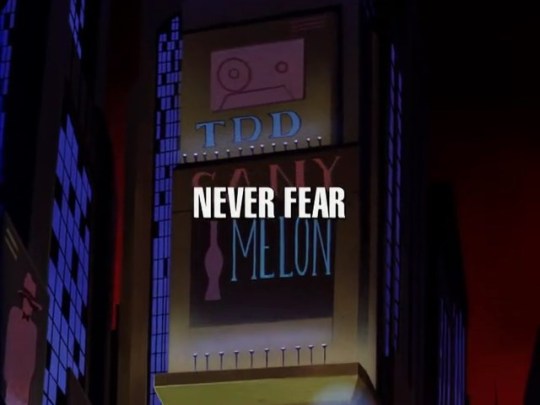
Out of all the Scarecrow’s appearances in B:TAS, this episode from the TNBA era is generally considered to be the best. It’s one of several stories taken directly from the comics, too, as the episode is (somewhat loosely) based on the comic tale “Fear For Sale.” The original comic was published in 1987, and was chiefly created by writer Mike W. Barr, and artist Alan Davis. While that story is really, REALLY freaking good – seriously, one of the Top 5 best Scarecrow comics, in my opinion, without question – I honestly think the Animated Series adaptation is even better. Not only that, but in some ways – despite the fact no one actually dies in this story (though several come awfully close) – I would argue the cartoon is darker than said comic, as well. Wrap your head around that!
The premise focuses on the Scarecrow returning to Gotham City, presumably after a long dormancy, with a brand new form of his Fear Toxin: instead of the usual method of installing fear in people, causing them to hallucinate violent apparitions and have horrifying visions of their greatest phobias and traumas, this new gimmick TAKES AWAY people’s fear. Now, one may wonder, why is that such a bad thing? Well, here’s the thing: fear is a rational human response, intended to keep us out of danger. We run away from things that scare us, or stay alert for trouble in times of distress, for self-preservation’s sake; we avoid doing certain things at least partially because fear reminds us of the consequences of those actions.
If you REMOVE fear…then a person has no restraints, no cares, and quite possibly no conscience. This is where things get interesting: while going undercover to try and figure out Scarecrow’s plans, Bruce gets a dose of the Anti-Fear Toxin himself. Batman becomes impulsive, thrillseeking…and, most alarming of all, homicidal. It’s therefore up to Robin to keep Batman from going down a path he must not travel, while also trying to stop the Scarecrow’s newest bid for power.
The first thing most people talk about with this episode is Scarecrow himself, and for good reason. The character is given a brand new voice, provided by Jeffrey Combs for this outing, as well as a brand new look, which most people agree is far superior to the one from the first three seasons. While the Scarecrow is great in those earlier seasons, I do agree with the apparent majority that the version found in “Never Fear” is a superior rendition, simply because he’s much more creepy to behold and to hear. I was never really scared of the Scarecrow himself in his earlier outings, but this version is a whole new story. The uniqueness of his plan in this story is also worth commending, whether it’s based on an already-published comic or not.
However, I think a lot of people underestimate what a good episode this is for Batman and Robin, as well. I may or may not have said this in an earlier entry, but I actually preferred Tim Drake as Robin over Dick Grayson, at least in the Animated Series. This episode is a great example of why. Robin really takes the spotlight and initiative here, as it’s ultimately really Tim that saves the day. There’s this great scene that I absolutely love, where Batman – under the influence of Scarecrow’s toxin – tries to convince Tim, after Robin ties him up to keep him from hurting people or running into trouble, to let him go. Kevin Conroy’s performance is so convincing, it almost tricks the viewer, as well as Robin himself, but Tim doesn’t take the bait. The two really do feel like partners here, in a lot of ways, and it’s a great tale for both. Whether you love it for the heroes or the villain, “Never Fear” is arguably the pinnacle of Scarecrow storytelling in the Animated Series.
I say “arguably” because of one other episode I’ll get to later in the countdown…but that’s another story.

Tomorrow we move into the Top 15!
Hint: “Kids these days. No respect.”
#list#countdown#best#favorites#new year's special#year of the bat#top 31 btas episodes#btas#batman: the animated series#tnba#the new batman adventures#dcau#dc#batman#animation#tv#number 16#never fear#scarecrow#jonathan crane#tim drake#robin#bruce wayne
14 notes
·
View notes
Text
yoooo. episode 46 of btas. oh my god??? new favorite episode. every like 3-5 episodes is another one where i'm like New Fave Episode and then they keep topping themselves MY GOD
it's the one where the five batman villains you've heard of talk about how they Almost Got 'Em (killed batman) over a card game. poison ivy had poison gas. she's immune to everything including the pain and suffering of others. Hot. two face tried to flip him on a giant fucking penny. OK. the penguin had birds. ... killer croc had a Big Rock. the joker does some wacky shit on saturday night live. catwoman saves him, it's Epic. LOOK AT HOW THEY OPEN THE EPISODE I LOVE IT IT LOOKS SO GOOD
I haven't even finished it yet i just had to come yell about this. 'cause when batman showed up to bust them it blew my mind. i'm not even gonna spoil it xD yeah i know this show is...31 years old. i don't care it's worth it i promise
#the two face one is killing me SIR. WHY NOT FLIP THE COIN TO DECIDE WHETHER OR NOT TO SHOOT HIM IN THE HEAD#what is this...guild of calamitous intent shit LMAO#batman#batman the animated series#btas#video#ramble
30 notes
·
View notes
Text
Year of the Bat - Number 29
Welcome to Year of the Bat! In honor of Kevin Conroy, Arleen Sorkin, and Richard Moll, I’m counting down my Top 31 Favorite Episodes of “Batman: The Animated Series” throughout this January.
EPISODE QUOTE: “The final stunt IS the best.”
Number 29 is…The Ultimate Thrill.
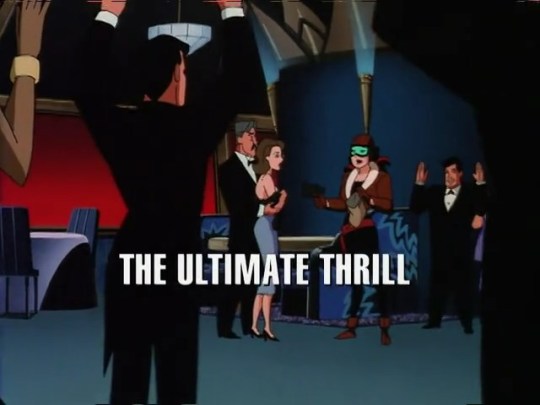
This is widely regarded as the most…um… “suggestive” episode in “Batman: The Animated Series.” While the show was not above a few innuendos and implications here and there, they were usually pretty subtle. This episode, rather infamously, basically turns any undertones into overtones: subtlety is not part of the game. You can decide if that specific element is a good or a bad thing, but it certainly makes it memorable. Regardless, that’s NOT the real reason I love this story.
“The Ultimate Thrill” focuses on the exploits of a character named Roxy Rocket: an original villainess created for the DCAU. She actually got her start in some spin-off comics for the franchise; the creators enjoyed the concept of the character so much, they finally gave her an animated outing with this story. The basic plot is pretty simple: Roxy teams-up with the Penguin, stealing jewelry for him while he acts as the fence, paying her for her work and then pawning off the baubles to the highest bidder. Penguin gets fed up with Roxy’s overzealous thrillseeking, however, and – out of fear she may cause trouble for his business at the Iceberg Lounge – tries to have her assassinated. Batman must now try to capture Roxy, before Penguin’s minions get to her first.
It's the two villains who make this story so memorable. In Penguin’s case, this is the only really major story he had in the New Batman Adventures era of the show. He popped up frequently throughout season four, but it was usually as a cameo or just a minor supporting role. In this story, he’s the main villain (not the main ANTAGONIST, but the main VILLAIN; there’s a difference), and I really like the way he’s used here. By this point in the series, Oswald Cobblepot had seemingly reformed and was running a prestigious nightclub called the Iceberg Lounge…but was secretly still a villain, doing his dirty deeds out the back window. It was great to see that character concept in full action here.
Roxy, however, is the one who truly makes this story. Her origins are only described, not shown, but setup for the character is really great: once upon a time, Roxy was a movie stuntperson, and an aspiring actress. However, her stunts became increasingly dangerous, to the point where no one wanted to hire her for fear of either herself or others being hurt in the process. Roxy thus turned to a life of crime, figuring that nothing could be more thrilling than the life of an outlaw. We’ve had other villains who enjoyed the thrill of the chase, so to speak – Catwoman is a good example, for instance – but none quite so…intensely as Roxy Rocket. To say that Roxy is an adrenaline junkie is putting it far too mildly. It’s made pretty darn obvious that she basically “gets off” on thrills; that’s where so much of the more suggestive side of the story comes from.
Even ignoring that specific angle, though, it’s just interesting to see HOW MUCH of a thrillseeker Roxy is. She will do literally ANYTHING, it often seems, just to get some excitement. From very simple things, like mock-gambling, to outright taking pleasure out of the thought of her own possible demise, it seems like she’ll try just about whatever, short of murder, simply for the sake of a little excitement. On that note, yeah, Roxy’s also not really depicted as outright EVIL, but simply a thrillseeking lunatic: in both this episode and her comic appearances from the DCAU, she’s consistently depicted as being much less violent and cruel compared to a lot of other baddies. There are even hints of a sort of self-deluding naivete to Roxy: she describes herself out loud as “the heroine of the story,” and seems legitimately shocked when other characters turn against her. When Penguin tries to kill her, she’s absolutely flabbergasted. When Batman snaps the cuffs on her at one point, she’s genuinely confused why. I love the different layers of this character, and I really wish we could have seen more of her…but you can certainly say that her single appearance (barring a Superman crossover) was a banger.
Did I mean it “that way” when I said “banger”? Maybe, maybe not. With Roxy Rocket, neither would be surprising. Ha Ha.
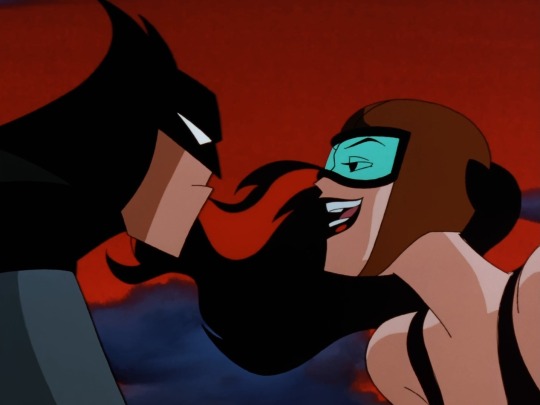
Tomorrow we move on to Number 28!
Hint: “Sometimes there are no happy endings.”
#list#countdown#best#favorites#new year's special#year of the bat#top 31 btas episodes#btas#batman: the animated series#dcau#dc#batman#animation#tv#roxy rocket#number 29#the ultimate thrill#the new batman adventures#tnba#penguin#oswald cobblepot
11 notes
·
View notes
Text
Year of the Bat - Number 24
Welcome to Year of the Bat! In honor of Kevin Conroy, Arleen Sorkin, and Richard Moll, I’m counting down my Top 31 Favorite Episodes of “Batman: The Animated Series” throughout this January.
TODAY’S EPISODE QUOTE: “As Napoleon told me, ‘A strong will can fuel a frail physique.’”
Number 24 is…The Demon’s Quest.
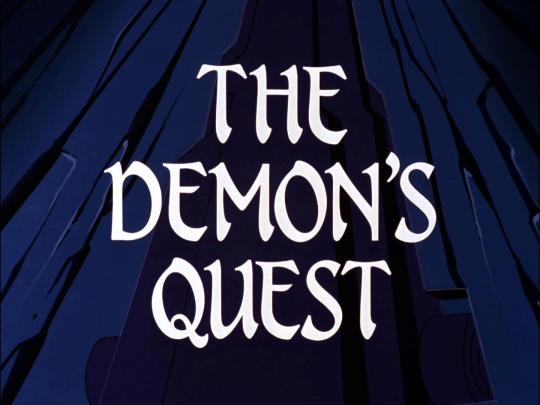
This is the first of a few entries on the countdown that’s actually a two-part story. The episode marks the official start for one of Batman’s greatest villains, Ra’s Al Ghul. The character had ACTUALLY debuted as part of a twist ending to another episode, “Off Balance,” but it was with “The Demon’s Quest” that Ra’s became a fully-fledged member of the Dark Knight’s Rogues Gallery in the series. This story also happens to be the first on the list actually based on a pre-existing comic, namely the seminal story “Daughter of the Demon,” created by Denny O’Neil and Neal Adams.
The two-part story begins with Ra’s Al Ghul appearing in the Batcave, officially introducing himself to Batman and making it clear he knows Bruce’s secret identity. However, Ra’s isn’t there to fight the Caped Crusader. Instead, he wishes to join forces with him: it’s revealed that Robin has been kidnapped, and – coincidentally – it was by the same people who have recently kidnapped the Head of the Demon’s own daughter, the lovely Talia Al Ghul (whom Batman also previously met and became fascinated by in “Off Balance”). I don’t think I’m spoiling much by saying that it’s later revealed Ra’s is the one responsible for the kidnapping, and all this was a ploy to try and win Batman over to his side. However, Batman isn’t taken in by all this, and when he learns more about Ra’s and the Society of Shadows (a.k.a. The League of Assassins), he quickly turns from working with Al Ghul to trying to find a way to stop his mad plans of destruction.
Ra’s was already pretty well-known in comics at the time, but for various reasons, hadn’t really reached mainstream popularity yet. While it would be a lie to say the DCAU catapulted him to stardom, his appearances in B:TAS and later spin-offs DID help to make him more familiar to non-comic readers around the world. Chances are that Ra’s wouldn’t be the villain he is now if this show hadn’t come about. (Well…this show and “Batman Begins,” but…details, details.) The character was played by the late, great David Warner, and is perhaps the definitive take on Ra’s beyond comics proper. (Not necessarily the best or my favorite, mind you, but certainly the one closest to the original source, in a lot of ways.) This two-parter established the villain and the kinds of stories he’d be most prominently featured in from this part on. The episode feels sort of like a cross between Indiana Jones, with a hint of pulp fiction like The Shadow or The Phantom thrown in, crossed with…well…Batman. It’s a globetrotting adventure story that just so happens to involve superheroics in the mix, so to speak. It’s definitely one of the most epic stories in scale the show ever produced.
I honestly feel pretty bad for leaving this one so low in the ranks. There’s really not much I can say as to why it isn’t higher up; I guess, end of the day, I just like other episodes more. Make no mistake though, this is a great story to look at: if you’re a fan of Ra’s Al Ghul, and if you’re only going to watch one episode of the character from this show, make this two-parter your pick of the bunch. You won’t regret it.

Tomorrow we move on to Number 23!
Hint: “At what point did I become life’s punching bag?”
#list#countdown#best#favorites#new year's special#year of the bat#top 31 btas episodes#btas#batman: the animated series#dcau#dc#batman#animation#tv#number 24#the demon's quest#ra's al ghul#talia al ghul
9 notes
·
View notes
Text
Year of the Bat - Number 5
Welcome to Year of the Bat! In honor of Kevin Conroy, Arleen Sorkin, and Richard Moll, I’ve been counting down my Top 31 Favorite Episodes of “Batman: The Animated Series” throughout this January. We’re now in the Top 5 of the countdown!
TODAY’S EPISODE QUOTE: “My fault…I didn’t get the joke…”
Number 5 is…Mad Love.
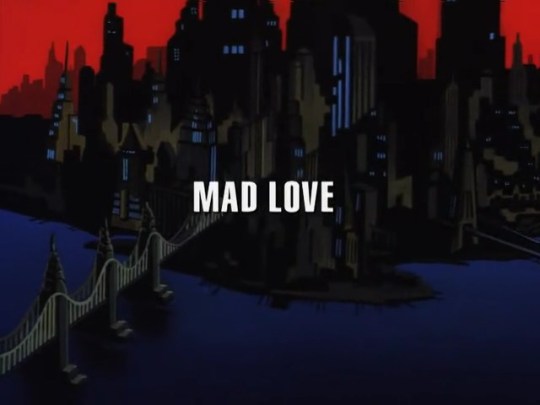
It was hard to choose between “Mad Love” and our previous pick, “Heart of Ice.” In some ways, I would honestly argue the latter is technically better than the former…but the reasons I place “Mad Love” over it are twofold. One, I just like Harley more than Mr. Freeze, in general. Plain and simple. Two, while “Heart of Ice” helped to re-invent a backstory for a great villain, and thus revamped them in an inspired way for future generations…this story is a bit different. Originally published as a spin-off graphic novel for the show, “Mad Love” was adapted into an actual episode during the TNBA era. It is the official origin story for Harley Quinn, and – considering everything that goes into Harley BEING Harley, so to speak – I think that’s an even more noteworthy achievement.
Harley’s origins had been hinted at a few times in earlier episodes, most notably “Harlequinade,” which I already covered earlier in the countdown. But “Mad Love” finally gave viewers the full scoop, and adapts its comic source pretty darn faithfully. With one or two possible exceptions (among them being the infamously…questionable redesign for the Joker in “The New Batman Adventures”), it once again improves on its source material, making Harley even more sympathetic than in the comic version, as well as tightening up the pace and using the full breadth of this visual, moving medium to its advantage.
“Mad Love” begins with Harley feeling fed up with the Joker paying more attention to Batman than to her. This causes her to reminisce on her past, and the full story of her background is revealed: once upon a time, she was Dr. Harleen Quinzel, a new up-and-coming psychiatrist at Arkham Asylum. It’s implied, however, that Harleen was more interested in using the inmates as research material for her own ambitions, than she really was with curing them. Her ambitions, combined with an inborn naivete, led to her being seduced by the Joker, and she fell in love with her deranged patient. After a particularly grueling battle with Batman left the Clown Prince of Crime badly injured, Harleen finally snapped, and – determined to help her “puddin’” out – she became the wild card that is Harley Quinn.
This, however, is not the end of “Mad Love.” That’s just the beginning. We cut back to the present, where Harley forms a surprisingly clever scheme to kill Batman, hoping that if he’s finally out of the picture, she can finally have the Joker all to herself. I feel hesitant to say much more in great detail, for a lot of reasons, but suffice it to say things don’t go the way Harley expected, and the audience is given an uncomfortably deeper perspective on the dangerous relationship she and the Joker have.
All three main characters – Batman, the Joker, and ESPECIALLY Harley Quinn – really make this story great. Harley’s origins themselves are classic, of course, and have really never changed much since this story. Certain details and elements have been expanded on or slightly altered over the years, but the basic concept has remained fixed. However, it’s the look at this trio and their relationships to each other that makes the story so splendid, as well as so disturbing at times. It also allows all three actors to deliver some of the best performances in the entire series; with the exception of “The Laughing Fish,” in fact, I would argue this is Mark Hamill’s single best performance as the Joker in all of the Animated Series (discounting movies and later series spinoffs, like “Justice League”). For Conroy, it’s an episode that allows his Batman to shine, even when he’s not the focus, as he shows his own cunning side in the way he’s able to manipulate both villains to come out on top. And of course, for Arleen Sorkin, this was the saddest, most heartbreaking story she ever got as Quinn, and she brings everything into it, showing that she could manage the tragedy of Harley as well as the humor.
Also, the title references a Peter Lorre movie. That’s just cool, A+.

We’re getting close to the end now, friends. Tomorrow we move on to Number 4!
Hint: “Gotham can be a Wonderland, Alice! Tonight, let me be your guide.”
#list#countdown#best#favorites#new year's special#year of the bat#top 31 btas episodes#btas#batman: the animated series#tnba#the new batman adventures#dcau#dc#batman#animation#tv#number 5#mad love#harley quinn#harleen quinzel#arleen sorkin#mark hamill#joker#kevin conroy#bruce wayne
12 notes
·
View notes
Text
Year of the Bat - Number 9
Welcome to Year of the Bat! In honor of Kevin Conroy, Arleen Sorkin, and Richard Moll, I’ve been counting down my Top 31 Favorite Episodes of “Batman: The Animated Series” throughout this January.
TODAY’S EPISODE QUOTE: “So, it wasn’t all for nothing.”
Number 9 is…Beware the Gray Ghost!
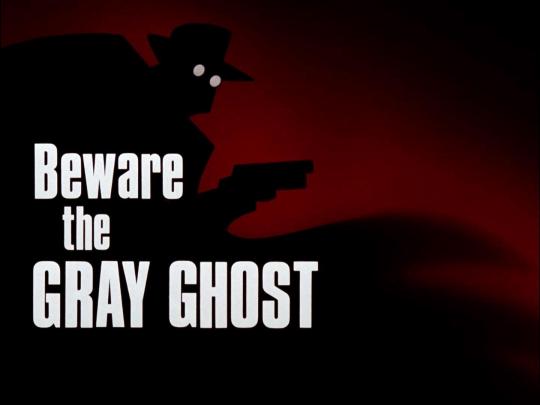
This is one of the greatest and most renowned episodes of the Animated Series…but as of these recent years, it’s also become one of the most difficult to talk about. In some ways, this episode is even more profoundly impacting now than it ever was before. It’s funny, because the reason(s) for this, I’m sure, will be lost on many future Batman fans; they will never know just how big a deal this episode was when it came out, and how big a deal it is now in this given year. Thankfully, however, those points will not detract from the greatness of this story on its own terms, and a great story is exactly what it is.
In this episode, Batman finds out about a series of bombings, committed by a mysterious villain simply referred to as “The Mad Bomber.” He recognizes the crimes as being almost identical, in every way, to the attacks of a fictional villain in a TV series that Bruce Wayne loved dearly as a child, “The Gray Ghost.” To try and solve the case, Batman gets help from the Gray Ghost’s original actor, an aging performer by the name of Simon Trent. Simon has seen better days, as the combo of his typecasting and other personal issues have led to him falling on hard times, and he’s grown bitter about the role that once made him a household name. Batman must find a way to not only stop the Mad Bomber, but reinvigorate Trent’s spirits, as he teams with the Gray Ghost himself to end the crime spree.
Much like the later “Legends of the Dark Knight,” this is an episode that essentially pays homage to Batman’s roots, but in a much more subtle way. I guess I can’t go any further without bringing up the big point: the voice of Simon Trent. It’s none other than Adam West: the original 1960s Batman. The creators of B:TAS were huge fans of the original Adam West series, and odes and homages to the show are sprinkled throughout, some more obvious than others. Trent’s character is one of the biggest examples, as his fictional foibles are a sort of exaggerated mirror of how West’s own career and life went after the 60s series ended. It goes even deeper than that, however: the Gray Ghost himself is a thinly-veiled parody of The Shadow, a character I’ve mentioned many times in the past, who was one of the main inspirations for Batman as a character. (The first Batman comic ever made was an outright ripoff of a Shadow story. No joke, look it up.) Even the villain of the piece feels more like something out of the Shadow than your typical Batman tale, let alone the silly sixties. It’s a double-homage, in a sense, to two great influences on the creators of B:TAS.
This is also what makes the episode hard to watch now: Adam West has been dead for only a few years now, yet, and Kevin Conroy’s passing is still even more painfully recent. You can’t watch this episode as a Batman fan without feeling a sort of pang, realizing not only the significance of two of the greatest Batmen in history onscreen together, but the fact that both are no longer with us. In a weird way, though, that makes the episode even more powerful, because of what the whole story is really about: nostalgia. The way nostalgia effects all three of the main characters in the story – Batman, the Gray Ghost, and the Mad Bomber alike – is a BIG part of this story. Trent is someone who tries to shun the past, who feels pained when he looks back, and has to come to terms with the fact the world has changed, and he has to change, too. He’s haunted by the role that made him once iconic, while also dealing with the issue of being seemingly obsolete, no longer sure of who he is or what his life has truly become. The Bomber, meanwhile, is the opposite extreme: without giving away who it is, it’s someone who clings TOO CLOSE to the past, and to the things they loved in youth, and that obsession drives them to toxic self-destruction, not to mention acts of cruelty and spite. It’s probably not a coincidence that Bruce Timm, one of the show’s creators – a fan of the 60s series – plays this character; a sort of self-parody in the form of the world’s most unsettling fanboy.
It's Batman himself who shows the value of nostalgia and the balance of where it needs to fall: he clings close to his past, as we know, and the Gray Ghost character and series is revealed to be no exception. But he doesn’t allow these things to rule him or destroy him. For people who grew up with Kevin Conroy and Adam West alike, this episode shows just what made both of them such special actors, and reminds us of why both of their respective takes on Batman were so interesting, while also providing a fascinating story that combines all kinds of tonal elements to create an intriguing and entertaining tale. But above all, it serves as a lesson in the dangers and the values of what we keep close in our memories.
I think it’s fair to say that everything about this episode – it’s actors, it’s inspirations, and the series it hails from – will be a treasured, nostalgic memory for many years to come.
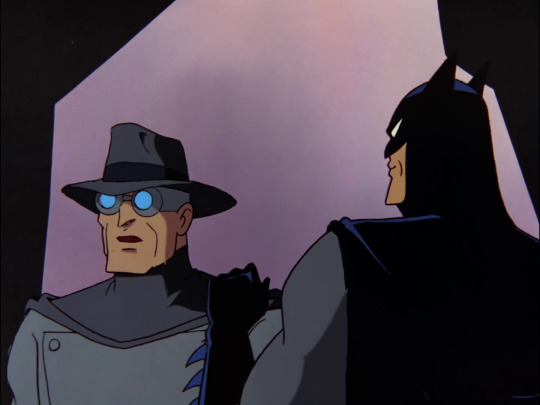
Tomorrow we move on with Number 8!
Hint: “But they share my unique face! Colonel Whathisname has chickens, and they don't even have moustaches!"
#list#countdown#best#favorites#new year's special#year of the bat#top 31 btas episodes#btas#batman: the animated series#dcau#dc#batman#animation#tv#number 9#beware the gray ghost#gray ghost#simon trent#adam west#bruce wayne#kevin conroy#mad bomber#bruce timm
11 notes
·
View notes
Text
Year of the Bat - Number 10
Welcome to Year of the Bat! In honor of Kevin Conroy, Arleen Sorkin, and Richard Moll, I’ve been counting down my Top 31 Favorite Episodes of “Batman: The Animated Series” throughout this January. Today, we’ve officially reached the Top 10!
TODAY’S EPISODE QUOTE: “Change is everything.”
Number 10 is…Two-Face.

How fitting is it we’re covering this villain’s origins on the 22nd? XD Anyway, I had a hard time choosing between this and “Feat of Clay.” Both are actually extremely similar in a lot of ways: both are two-part story arcs, both feature the origins of great villains in Batman’s Rogues Gallery – great villains whose appearances were teased in earlier stories, no less – and both feature great animation and an exceptionally dark, at times almost horror-movie-esque, tone. Not only that, but even the plots of these episodes bear some noticeable similarities!
With that said, the animated series definitely provided the best take on Harvey Dent we’ve ever gotten, at least outside of comics themselves. In previous episodes – specifically the series pilot, “On Leather Wings,” and Poison Ivy’s debut, “Pretty Poison” – we’d already met Harvey Dent and gotten to know him a bit. We knew he was Gotham’s rather well-liked district attorney, we knew he and Batman had a sort of rivalry going on, and we also knew that he and Bruce Wayne were best friends. All these facts made the events of this two-parter all the more disturbing, because we had gotten to know Harvey pretty well.
In this two-parter, it’s revealed that Harvey secretly suffers from some mental issues, and has a second personality inside him, referred to as “Big Bad Harv.” This second personality is all of Harvey’s repressed anger and bitterness, refined into one diabolical, snarly, cruel beast. When the DA gets too close to the schemes of crime boss Rupert Thorne, Thorne’s minions capture Harvey, and in the chaos that ensues, the DA’s face and body are horrifically disfigured. This causes Harvey to snap and become the supervillain Two-Face: a deranged gangster who vows to get revenge on Thorne, and make Gotham his own stomping ground in the process.
Harvey/Two-Face was voiced by the late Richard Moll, who – like many actors in later years – would reprise the role many times in other takes on the character. Like Mark Hamill and Kevin Conroy, Moll cemented the character and became the definitive interpretation. He is so wonderful as the vulnerable, tragic Harvey Dent, while his gravelly, gruff, snarly voice for Two-Face has become the gold standard which all other versions (at least in animation) seem to try and live by. Two-Face, himself, has always been one of Batman’s most tragic and personal enemies, and the Animated Series didn’t hold back on that front. Not only do the events of this story scar Harvey for life – both physically and mentally – but they also take a heavy toll on Bruce himself. This two-parter is magnificent not only because of how well it handles a great villain, but because of Batman’s role in the story, as well. In a lot of the villain introductions of the show, Batman is sort of a secondary player, in a way: the focus is either just on him trying to stop the villain in question, or on the villain’s descent into darkness.
This episode not only gives us both those elements, but it also gives us great character moments for Batman himself, as he has to struggle with the guilt and sorrow that comes with seeing one of his best friends become one of his most formidable opponents. We got bits and pieces of this kind of thing in other stories, of course, but “Two-Face” – perhaps because it has more time to manage things – really goes all out. This isn’t just a great episode for Two-Face himself, but a great episode for Batman as well. It’s for this reason, I think that I decided to rank this higher than “Feat of Clay.” There’s no doubt in my mind that it belongs in my Top 10.
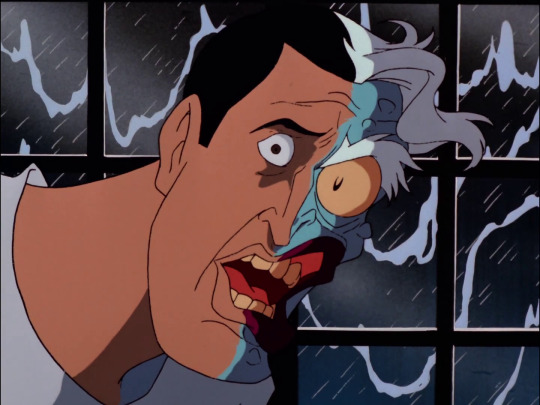
Tomorrow we move on with Number 9!
Hint: “So, it wasn’t all for nothing.”
#list#countdown#best#favorites#new year's special#year of the bat#top 31 btas episodes#btas#batman: the animated series#dcau#dc#batman#animation#tv#number 10#two-face#harvey dent#rupert thorne
11 notes
·
View notes
Text
Year of the Bat - Number 13
Welcome to Year of the Bat! In honor of Kevin Conroy, Arleen Sorkin, and Richard Moll, I’m counting down my Top 31 Favorite Episodes of “Batman: The Animated Series” throughout this January.
TODAY’S EPISODE QUOTE: “Without Batman, crime has no punchline.”
Number 13 is…The Man Who Killed Batman.

In contrast to our previous pick, “Appointment in Crime Alley,” this is one of the most comedic and quirky episodes of the entire series. It almost feels like a dark comedy you’d see in the 80s, more than anything else, and that’s part of what makes it so great! The plot revolves around a wannabe gangster called “Sid the Squid,” voiced by the marvelous Matt Frewer, of all people. The story begins with Sid going to his employer, crime boss Rupert Thorne, seeking help. When Thorne asks to know what’s going on, Sid begins to elaborate on his story, and most of the remaining episode plays out in flashback.
It's revealed that Sid was suckered into helping some of Thorne’s thugs with a scheme, the idea being the shrimpy little buffoon would distract Batman while the other goons got away. However, this plan works too well, and Batman is seemingly accidentally killed while trying to capture Sid. The runt of the underworld suddenly becomes hailed as a king of crime, but he soon finds his new reputation is more of a curse than a blessing. Things escalate to the point where the Joker himself seeks Sid out, hoping to find out if it’s true that the little weasel has destroyed the Dark Knight.
This is where things get interesting, and it’s why the episode is so greatly remembered: when the Joker finds out Batman might be dead, he first tries to prove that he isn’t by staging a robbery…and when he starts to realize Batman may truly be gone…he’s DEPRESSED. The Joker becomes crestfallen, unable to finish the job, genuinely saddened and hurt by the realization that not only has his nemesis apparently kicked the bucket, but that he wasn’t the one who did it! He throws a mock funeral for the Caped Crusader – accompanied by probably the greatest eulogy in fiction, and Harley Quinn playing “Amazing Grace” on a kazoo…no comment – and then tries to kill Sid by dropping him in a coffin into a vat of acidic chemicals, which may or may not be the same ones that turned the Clown Prince into what he is today. (That part is ambiguous.) All this stuff with the Joker is classic, and everyone talks about it; it’s equal parts dark, funny, and surprisingly sorrowful, making for one of the Harlequin of Hate’s greatest scenes in the entire franchise. Indeed, Mark Hamill – the voice of the Joker – has gone on record more than once saying this was one of his favorite episodes, and that Joker’s most famous quote from the story (our episode quote of the day) has always been his favorite line.
As great as the stuff with the Joker is, it’s far from all that makes this episode good! I won’t go into detail on how Sid escapes the Joker, and how the story ends, but suffice it to say, obviously, Batman isn’t ACTUALLY dead. In fact, he reveals he’s been trailing Sid basically all this time, hoping and waiting for the opportune moment to strike at Thorne in the process. (Which honestly makes the stuff with the Joker even funnier, when you realize Bruce was literally trolling the Ace of Knaves behind the scenes. Glorious.) Sid, himself, is actually a big part of what makes the story so much fun: he reminds me a lot of characters like Smee from “Peter Pan” or Kronk from “The Emperor’s New Groove.” In terms of comics, he also reminds me a lot of my preferred versions of Killer Moth: Sid is basically a fanboy of criminals, who wants the prestige and power famous crooks get. However, he’s way too dumb, way too clumsy, and way too softhearted to be any real threat or make a name for himself. This makes the way things end ironic and surprisingly heartwarming, and it keeps him from being an unlikeable or annoying character, because we realize he’s in WAY over his head, and it only gets worse and worse as the story goes on. We don’t exactly want Sid to win, but we don’t want him to suffer, either. He’s another case of an unusual protagonist, and one of the best examples the show ever gave us. Whether you love the story for him, the Joker, or even other reasons, there’s plenty that makes this episode a true classic.

Tomorrow we move on to Number 12!
Hint: “Life used to be so placid! Won’t you PLEASE put down that acid?! And Say That We’re Sweethearts Again!”
#list#countdown#best#favorites#new year's special#year of the bat#top 31 btas episodes#btas#batman: the animated series#dcau#dc#batman#animation#tv#number 13#the man who killed batman#sid the squid#joker#harley quinn#rupert thorne#harleen quinzel
9 notes
·
View notes
Text
Year of the Bat - Number 18
Welcome to Year of the Bat! In honor of Kevin Conroy, Arleen Sorkin, and Richard Moll, I’m counting down my Top 31 Favorite Episodes of “Batman: The Animated Series” throughout this January.
TODAY’S EPISODE QUOTE: “Some thought I had gone mad. Others thought I always had been, until they put me where I belonged.”
Number 18 is…Dreams in Darkness.
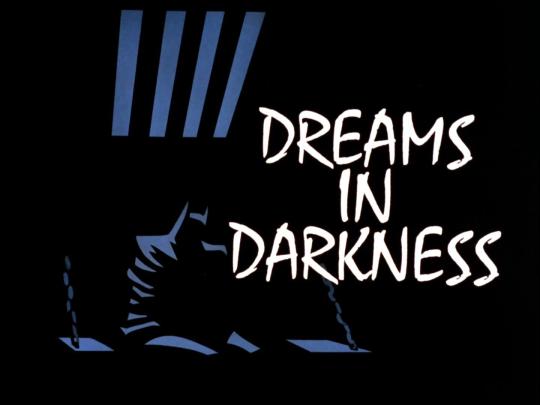
This is the first episode on the list to feature one of Batman’s most revered enemies, the Scarecrow, as the main antagonist. The character had a lot of really fun appearances the show, but in my opinion, this was probably his grandest story of the whole bunch, in terms of sheer scope and scale.
The story begins with Batman investigating a break-in at a spa resort, where he finds a high-tech crook tampering with the drinking water supply. In the scuffle, a device the crook was carrying bursts open, and a mysterious gas floods the room. Batman escapes, but as time goes on, he begins to experience horrifying hallucinations, as his greatest fears and paranoias all start to come to life right before his eyes. It doesn’t take long for Batman to realize Scarecrow is behind all this, and he soon realizes time is of the essence, as Scarecrow plans to poison the water supply for the entire city with a special new brand of his patented Fear Toxin.
In some ways, this episode is similar to the Scarecrow’s first appearance, “Nothing to Fear.” In that one, he sprays Batman with the Fear Toxin early in the story, and for much of the rest of the episode, the Dark Knight must confront and deal with his greatest fears coming to life. “Dreams in Darkness,” however, goes way further with the idea of Batman battling his worst fears, taking the same basic idea and upping the stakes in a big way. Not only do the visions grow more intense the longer Batman goes untreated – the antidote for this specific blend of the Toxin will render him unconscious for two whole days, and he can’t waste any time – but after one particularly shocking vision causes Bruce to crash the Batmobile, he’s actually locked up in Arkham Asylum. He must now find a way to escape the Asylum and stop Scarecrow’s mad scheme, all while still under the effects of Crane’s newest formula.
I love the way this episode builds, and the way it’s structured. The story actually begins with Batman already locked up in the Asylum, and for much of the story, he acts as a Narrator, telling us all about what’s really going on and why. It kind of feels like something out of an old-fashioned radio drama, or – fittingly enough – the way a comic is written, with thought balloons and text boxes indicating the character’s thoughts and motives. I also love the emphasis on the “ticking clock” element in the story, as Batman has to do so much with so little time on his hands. It helps to keep things in suspense, especially as the nightmares Scarecrow’s new toxin creates become more and more wild, imaginative, and downright freaky as the story goes on. The idea of Scarecrow poisoning the whole city, rather than just a select group of people, per the norm, was also a gripping concept; I kind of wonder if “Batman Begins” took a few hints from this story in particular, since the Scarecrow in that film and this episode do bear some similarities, in terms of how they affect Batman and their evil schemes.
My only major gripe with this episode is Batman remaining unmasked while in the Asylum. I understand why they did it, of course; for one thing, it’s just a visually captivating concept. For another, it would have been…awkward if Bruce’s identity was revealed to so many people at once, especially in such an unceremonious fashion, and in a place where most of his worst enemies are all incarcerated. They do try to explain away the reason the doctors let him wear the cowl, but…ehhhh, I don’t personally buy it. I guess they had to figure out SOMETHING, though…and hey, if the doctors at Arkham were…you know…WAY better at what they do, Bruce would probably have a MUCH easier night life. :P Despite this nitpick, “Dreams in Darkness” is still a great (and magnificently animated) episode of the series, and easily one of Scarecrow’s personal best as a villain. I highly recommend it.
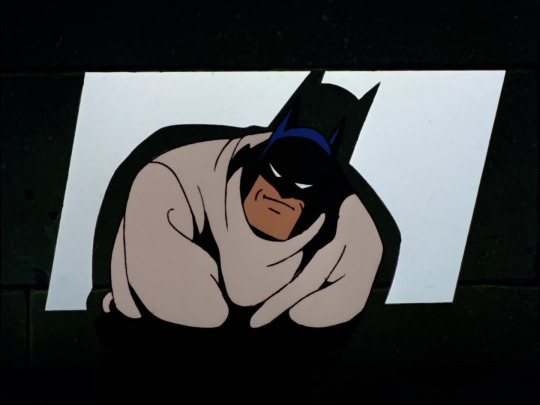
Tomorrow we move on to Number 17!
Hint: “Man or woman, a sick mind is capable of anything.”
#list#countdown#best#favorites#new year's special#year of the bat#top 31 btas episodes#btas#batman: the animated series#dcau#dc#batman#animation#tv#number 18#dreams in darkness#bruce wayne#jonathan crane#scarecrow
12 notes
·
View notes
Text
Year of the Bat - Honorable Mentions
Welcome to Year of the Bat! In memory of Kevin Conroy, Arleen Sorkin, and Richard Moll, I will be counting down my Top 31 Favorite Episodes of “Batman: The Animated Series” throughout this January
Before we get to that, though, I decided to take today to present a few Honorable Mentions. These were Twelve Terrific Episodes that ALMOST made the Top 31, but didn’t quite cut it for me.

A Bullet for Bullock.
One of the more unsung things the Animated Series did was bring the character of Harvey Bullock to the spotlight. Bullock is, in my opinion, one of the more underrated characters in Gotham City; he’s not exactly one that’s a household name, and only a few adaptations of comics utilize him to any great degree, if at all. The Animated Series was among them. In this episode – based on a comic of the same name – Bullock becomes the main character, as he is forced to get Batman’s help in order to find out who has been making frequent attempts on his life. The episode sort of riffs on the ideas of film noir, and rides a fine line between dark comedy and mystery thriller. Seeing Batman and Bullock – two constant rivals throughout the show – work together, however begrudgingly, is also quite interesting.
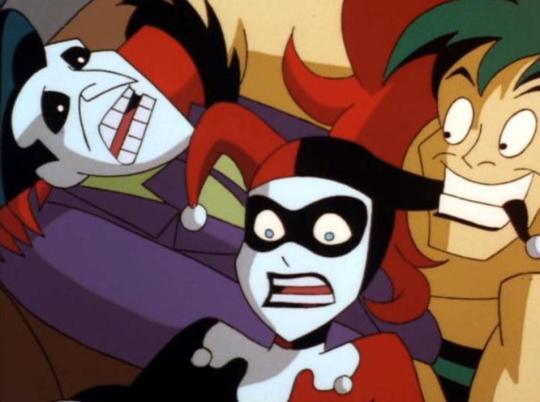
2. Beware the Creeper.
The first episode to be mentioned from “The New Batman Adventures,” and another inspired by a comic. (In this case, the story is very, VERY loosely inspired by “The Last Ha-Ha,” from the Joker’s nine-part miniseries from the 1970s…yes, that was a thing.) “Beware the Creeper” gives us the origins of a new vigilante in Gotham City, the Creeper: a journalist named Jack Ryder, who goes completely insane after being thrown into a vat of chemicals by the Joker himself. Ryder – his skin dyed yellow and hair dyed green by the chemical bath – goes on a rampage of chaos and revenge, seeking to get back at the Clown Prince of Crime, while also becoming smitten with Harley Quinn. The episode starts off honestly pretty dark, but then goes into something that feels more like an episode of “Freakazoid” than your typical Batman adventure. (The fact he’s voiced by “Freakazoid” alumni, Jeff Bennett, probably isn’t a coincidence...although the fact Bennett would, himself, later play the Joker probably is.) It’s easily one of the funniest episodes of the entire series.

3. Deep Freeze.
Ever wanted to see Batman battle Walt Disney? Well, tough luck, I don’t think that ever happened…but this episode KIND OF scratches that itch. “Deep Freeze” was the second appearance of Mr. Freeze, a villain who was truly revolutionized by the incarnation found in the Animated Series. While the stuff with Freeze is, of course, really fantastic – tapping into the gray areas of the character’s morality in a very interesting way – I personally find this more interesting because of the ACTUAL main villain of the story: Grant Walker, a corrupt theme park mogul. Walker is a very direct and obvious parody of Walt Disney himself: the character is an amalgamation of urban legends and rumors about Walt’s life (and even Disney’s death), with a philosophy to his villainy that is essentially a twisted and warped version of Walt’s own ideals. His evil lair is a straight-faced parody of Disneyland! Being the Disney fanboy I am (and also being someone who will concede that, for as great a man as he was, the real Walt was not exactly a flawless person), it’s really cool to see a character like that in a Batman cartoon, and spot all the references and homages. Even if you don’t get all of it, Walker is just a great villain, and makes a fantastic foil for both Batman AND Mr. Freeze. I feel this episode often gets overlooked, but it’s definitely one worth checking out.

4. Double Talk.
This was the final episode to feature two of my favorite, more underrated villains from the Caped Crusader’s Rogues Gallery, the Ventriloquist and Scarface. While I will come right out and say their designs in “The New Batman Adventures” are a bit…odd (which, to be fair, permeates many of the redesigns here), the actual story is so good, it almost doesn’t matter. For those who don’t know, the Ventriloquist – Arnold Wesker – is seemingly mild-manner gentleman whose dark alter ego, Scarface, is expressed through his ventriloquist dummy. In this story, Arnold is seemingly cured of his dual identity crisis, and tries to go back into society to live a normal life. However, after a while, he starts seeing Scarface everywhere, and hearing his voice when he shouldn’t. No longer sure what is real and what is not, Wesker struggles to find a way to escape his darker half once and for all. The twist of who’s behind all this, while admittedly somewhat expected, was still pretty neat, and seeing poor Arnold fight to keep his sanity and stay on the straight and narrow was naturally an engaging setup, and led to some creepy and intriguing visuals. The series did a lot of “Villain Reform Episodes,” which have all become famous in their own right. I personally think this is one of the best.
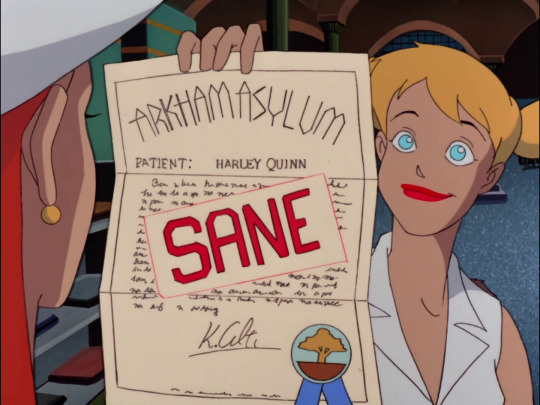
5. Harley’s Holiday.
Another villain reform episode, and quite possibly the funniest of them all! This was the only appearance Harley Quinn had in the Animated Series where she did NOT get backup from other major villains, like the Joker or Poison Ivy. Her only solo starring role, and it’s definitely a memorable and delightfully zany experience. In the story, Harley is released from Arkham with a clean bill of health, but she very quickly grows frustrated with the real world and turns back to crime, her sanity slipping away once more. This culminates in her taking wealthy socialite, Veronica Vreeland – a friend of Bruce Wayne’s – on a wild joyride, which sees both of them pursued by not only Batman, but also a group of gangsters, Harvey Bullock, and an overzealous army commander IN A TANK. The episode is something of a superhero sitcom, and it’s got a lot of funny moments and lines. The only reason it isn’t in the Top 31 is that I sort of wish this one had been a two-parter. I feel it could have gone even further with both the comedy and Harley’s return to lunacy if it had been given more time. But for what we got, it’s still a fun story that shows why Harley is so well-loved today.

6. Joker’s Millions.
So, fun fact: this episode is based on the very first Batman comic I ever read. Seriously. The first Batman story I ever read was the late Golden/early Silver Age comic, “Joker’s Millions,” in which the Clown Prince of Crime inherits an apparent fortune from a recently deceased gangster who was one of his rivals in crimedom. With all the money in the world at his fingertips, the Joker abandons crime in favor of just living the good life…but it eventually turns out that the gangster has pulled a joke on the Joker from beyond the grave. Most of the money, you see, is actually phony, and with so little of the real stuff now left to his name, the Joker has to figure out a way to gain more, or else he’ll be in trouble with the one foe even HE won’t dare take on head-to-head: the IRS. The episode follows this basic premise, but takes several new detours of its own that makes it really its own beast, such as bringing Harley into the mix and spending more time with the Joker as an apparent millionaire (most of the original comic focuses on the Joker’s attempts to salvage his reputation and fortune after realizing he’s been hoodwinked). I know a few people who feel this episode is almost out of character for the Joker, especially in light of so many recent versions that REALLY push the “who cares about money?” angle, but considering the Joker is canonically strapped for cash at the start of this story, and throughout Season 4 in general, I think it holds up. Plus, being based on a comic so near and dear to my heart definitely gives it a big boost.

7. Judgment Day.
This is one of two episodes in the Honorable Mentions I feel particularly bad for not including in the main list. One of the final episodes of the show, “Judgment Day” focuses on a new, deadly vigilante who comes to Gotham, the Judge. The Judge is hellbent on destroying the lives of all of Gotham’s supercriminals, using much nastier means than Batman ever would. Several famous villains, including Penguin, Riddler, and Killer Croc are all severely injured and nearly killed by this new menace. Batman must figure out who is behind the Judge’s cloak and wig, and stop this deadly threat to his own rogues gallery; the irony abounds. I think part of the reason I don’t like this episode AS much as other people is simply because I’ve seen this idea done before and since in ways that I personally enjoyed more, with some new enemy coming to Gotham to threaten the criminals rather than the innocents. It was, however, interesting to see which specific villains got targeted and how, and the twist ending behind who is truly the Judge – widely considered one of the best twists in the entire series – definitely made the whole journey worthwhile.
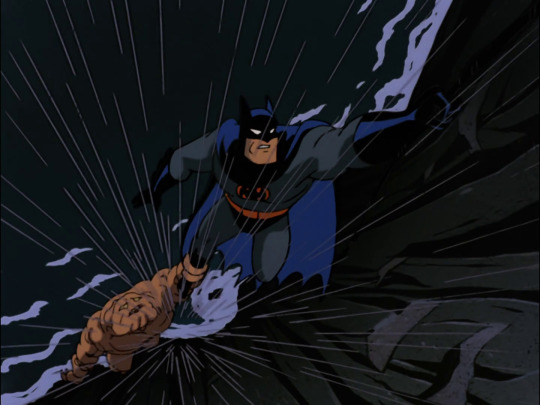
8. Mudslide.
This is often considered one of the more gut-wrenching episodes of the show…and since it involves Clayface, that’s saying quite a lot, since he honestly had a LOT of really messed-up and emotional stories throughout the series. In this one, Clayface’s nasty condition worsens, as he is finding it difficult to keep his clay-like form together in one piece. At best for him, this makes him sluggish and more vulnerable; however, the worse it gets, the more likely it is that Clayface will just melt away into a formless mass of goo, and thus perish. Desperate to regain his humanity, or at least keep himself alive, Clayface infiltrates a Wayne Enterprises Biomedical branch to try and find the cure he needs. I’ve always had mixed feelings about this episode, personally: on the one hand, it’s a very gripping story, and has some great visuals in it…but on the other hand, by virtue of the story focusing on a slower, less powerful, more pathetic Clayface, it feels like the character loses some of his punch. Then again, I suppose that WAS the point, and he still does manage to prove a threat in several necessary places. Of course, there’s one particular moment that’s ESPECIALLY notable, and if you’re a Clayface fan (I’m talking kinks here, so you know), you’ll know what it is…but I digress. Regardless, it’s still a great episode.
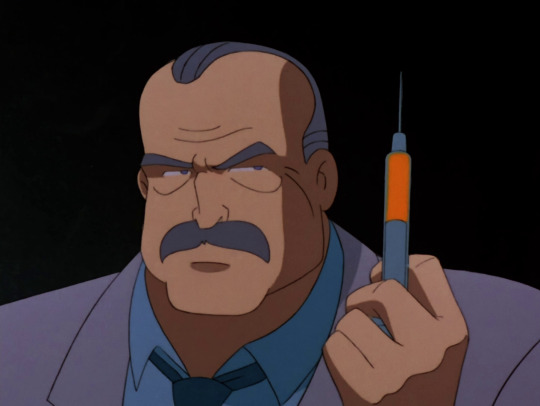
9. Paging the Crime Doctor.
This episode introduces us to Matthew Thorne: the brother of nefarious gangster Rupert Thorne, who was a recurring antagonist throughout BTAS. Matthew is a former surgeon, who was disgraced due to his connections to his black sheep of a brother; he now works underground as "The Crime Doctor," the finest underground physician any hitman or thug with an injury can go to. Matthew hates the work, but he has no choice, he feels, other than to keep doing this, serving under his brother's thumb. When Rupert requires a very dangerous life-saving operation, Matthew is forced to turn to an old friend for help. The events that transpire reveal secrets about Bruce's family history he never expected, and the story ends on a surprisingly sweet and hearfelt note. This is a more down-to-Earth story than many others in the show, and the Crime Doctor is a great character: it's a pity that he never really showed up again, because between his own issues and his connections to Bruce and the Waynes' past, he could have made an amazing recurring figure in the series.

10. Second Chance.
This episode is both a bit disturbing and yet also weirdly uplifting at the same time. It's an episode that provides a rare spot of hope and friendship in the dark world of Gotham City. The plot focuses on Harvey Dent - a.k.a. Two-Face - getting ready to undergo a surgery, which will hopefully give him the normal, handsome features he once had, and help his therapy along as he tries to become a sane and wholly good human being again. Bruce Wayne, of course, is eager to see this done, but Dick Grayson is less sure things will go the way Bruce hopes. Sure enough, Two-Face gets kidnapped from the hospital, and Batman and Robin both take separate paths to try and figure out what's really going on. The twist on who arranged Harvey's abduction is one of my favorites in the show, and a sign of what made Two-Face episodes so great. I love how the relationships between Bruce and Harvey AND Batman and Robin both get a lot of spotlight here, as both sides learn the value of never giving up hope and listening to those you trust. For all the dark moments in the show and the episode, that's a surprisingly heartwarming message.
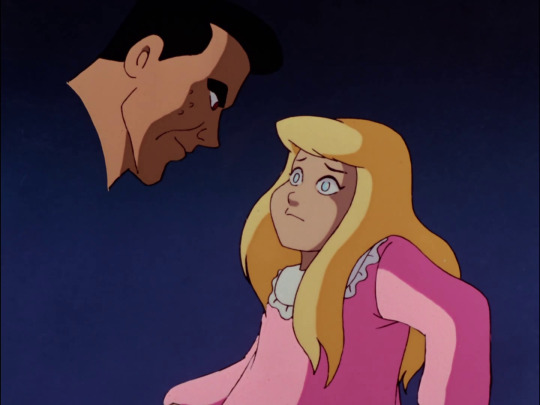
11. See No Evil.
Not all of the best episodes of “Batman: The Animated Series” focused on him facing his famous rogues or going on grand, epic adventures. Sometimes, smaller adventures with smaller enemies and smaller problems could be just as interesting. “See No Evil” is a great example of this. Inspired by the H.G. Wells classic “The Invisible Man,” Batman is brought into a case of a seemingly invisible jewel thief. It turns out the thief is a man called Ventrix, who has stolen some of an experimental material that renders him invisible. Why is he doing this? Well, Ventrix is the estranged father of a young girl named Kimberly, and he’s using the invisibility suit to give himself a way to see his daughter, masquerading as her “imaginary friend,” known as Mojo. The problem is that the material is not fully tested, and is steadily eating away at the man’s sanity. With both father and daughter in danger for different reasons, Batman must find a way to stop Ventrix and end the invisible man’s reign of terror. While the gimmick of invisibility makes for some great moments, it’s really the core struggle of the episode that makes this story so haunting and so powerful. Ventrix is probably one of the more complicated villains in the series, since all he really wants is to be with his daughter again. However, the methods he uses to try and be with her make him the antagonist, and his attitude ranges from borderline sweet and pitiful…to genuinely REALLY freaking creepy, which makes his exact intentions more ambiguous. It’s a story that blends real world problems and gray areas with a more fantastical side befitting of superhero fiction, and makes for one of the most unsettling and memorable one-off stories of the show.

12. The Worry Men.
This episode mostly gets into the Honorable Mentions because of its villain of choice: Jervis Tetch, a.k.a. The Mad Hatter. Anybody who knows me knows that I love the Batman version of the Mad Hatter, and that I’ve always considered the version from B:TAS to be the very best imagining of that character. In “The Worry Men,” the Hatter decides to retire from crime…ironically, by committing crimes to fund said retirement. A bit backwards, but hey, they don’t call him the MAD Hatter for nothing, you know. Anyway, to achieve this, the Hatter kidnaps an African Shaman and has him create a bunch of “Worry Men” – small dolls that supposedly remove a person’s worries and help them have good dreams at night. In reality, the dolls are filled with the Hatter’s patented mind control technology, which causes anybody who gets one to deliver their most prized possessions to the madman’s henchmen. When Bruce Wayne gets victimized by accident as a result, he is put on the Hatter’s trail, which leads to probably one of the most wild showdowns of the program, in terms of imagery. I won’t go into details on what happens, but suffice it to say, it’s more than worth a watch. While by no means one of the most complex stories in the series – it’s a fairly straightforward action/adventure superhero tale – it’s one of the best animated and one of the most visually memorable. Top that off with the villain being a character I enjoy so much, and it’s more than worthy of an Honorable Mention.
Tomorrow, the countdown begins with earnest with Number 31! I’ve decided that, for hints in this event, I’ll be providing quotes from each episode featured. With that said…
Hint: “I am the cat who walks by herself.”
#list#countdown#best#favorites#new year's special#year of the bat#top 31 btas episodes#btas#batman: the animated series#dcau#dc#batman#animation#tv#honorable mentions
11 notes
·
View notes
Text
Year of the Bat - Number 3
Welcome to Year of the Bat! In honor of Kevin Conroy, Arleen Sorkin, and Richard Moll, I’ve been counting down my Top 31 Favorite Episodes of “Batman: The Animated Series” throughout this January. We’re now in the Top 3 of the countdown!
TODAY’S EPISODE QUOTE: “Look at us. We’re all freaks and monsters? And who made us this way? BATMAN!”
Number 3 is…Trial.
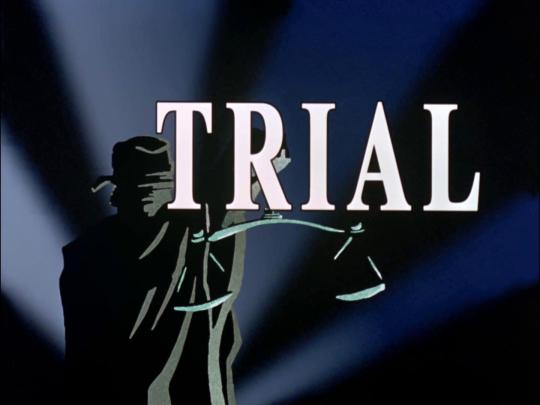
“Who made who?” This is not only a quote from a very fine song by AC/DC, but it is a recurring question found and toyed with in a variety of ways throughout superhero fiction. Do the heroes create the villains, or do the villains create the heroes? Does extreme heroic action, that which already tends to bend the law (if not break it completely) result in higher extremes of crime and cruelty? Or does the existence of such evil in the world beget the need for heroes who will go to greater lengths to stop them? Is it, perhaps, a hint of both, or could it even be neither and it’s all sheer bizarre coincidence; that these things would probably happen regardless?
While basically every superhero franchise worth its salt dives into this question somehow, some way, at some point, Batman is one of the characters who perhaps most embodies this fundamental problem: keep in mind, most of Batman’s greatest villains – especially in B:TAS – only came on the scene after Batman, himself, arrived. Does his presence in Gotham in some way inspire evil, or is it the presence of said evil that necessitates his constant intervention? “Trial” is one of my favorite pieces to address this question. Originally planned to be a movie, the story was tightened up to be just another episode of the show (I think budgetary reasons might have been the cause, but I can’t prove or be certain of that). While one does wish the episode could have been expanded on in feature format, I think the final result more than stands up on its own terms.
The story focuses on Gotham’s new district attorney (replacing Harvey Dent), Janet Van Dorn. She greatly disapproves of Batman’s involvement with law enforcement, not at all impressed by his many feats of saving Gotham City, and frustrated with Commissioner Gordon’s alliance with the Dark Knight. In her mind, Batman is responsible for the rise of super-criminals in the city, and she openly admits that nothing would bring her greater pleasure than to put the Caped Crusader on trial. As the old saying goes, “be careful what you wish for”: Van Dorn and Batman both find themselves captured by a horde of Gotham Rogues, who have staged a coup to take over Arkham Asylum, using the Mad Hatter’s mind control technology to brainwash the staff. The Villains reveal they plan to put Batman on trial: the Joker is the Judge, Two-Face is the Prosecutor…and Janet Van Dorn is forced to act as Batman’s Defense. The irony speaks for itself.
Where do I start with what’s awesome about this episode, aside from the obvious novelty of the premise? Well, for one thing, if you love Batman Villains, then you definitely will enjoy this story, because almost every major rogue in the gallery appears in some capacity in this episode. Some, like Scarecrow and the Riddler, are non-speaking cameos, but a lot of the others actually get a fair bit of screentime and some great character interactions and dialogue. Seeing all these villains bounce off each other, as well as our two protagonists, is just a great deal of fun. I also love all the little humorous elements and hidden jokes in the episode: things like the Mad Hatter being the first witness (a direct and subtle reference to the Wonderland books), the Joker being the judge (which I think may have been a reference to a comic, but could also be a funny coincidence), and the Ventriloquist & Scarface as the bailiffs (which doesn’t reference anything, I believe, but is just freaking hilarious).
I also like the journey Van Dorn goes on in this story. She starts off as a rival to Batman, seeing him as a nuisance and a hypocrite who causes more trouble than he’s worth, and wants to see things done in a straight-and-narrow fashion. By the end of the story, she concedes that he really does have a place and purpose in Gotham, and that the ends truly do justify the means…but she still doesn’t necessarily LIKE that fact. To an extent, she reminds me a lot of Ellen Yindel from “The Dark Knight Returns” (and her surrogate character, Ellen Yin, from the later animated show “The Batman”). In Frank Miller’s graphic novel, Yindel is Commissioner Gordon’s replacement, and she basically has the same concerns and feelings as Van Dorn. She also ultimately comes to the same conclusion: sometimes, drastic measures are called for, and one should not judge what they cannot fully understand. I don’t know if this similarity was intentional on the creators’ part or not, but it’s interesting to note.
“Trial” postulates that, unorthodox and questionable as his actions may be, Batman does NOT create his villains: whatever grudges and fixations these renegades have, they probably still would have become bad guys later down the line without his help. And what’s great about this conclusion is, at least in the Animated Series, that’s absolutely true! Most of Batman’s rogues are created independently from him, or were already off-balance by the time he came into play. So many times in this series, Batman isn’t the one spurring the action on, instead he’s reacting to dangerous activity. So whatever influence Batman has on Gotham City…in this show, at least, it’s safe to say it’s positive. The twist that comes after Van Dorn has this realization during the titular trial is absolutely marvelous, as well…but I think I’ll keep that one to myself. Watch the episode to see how this case adjourns. Ha Ha.
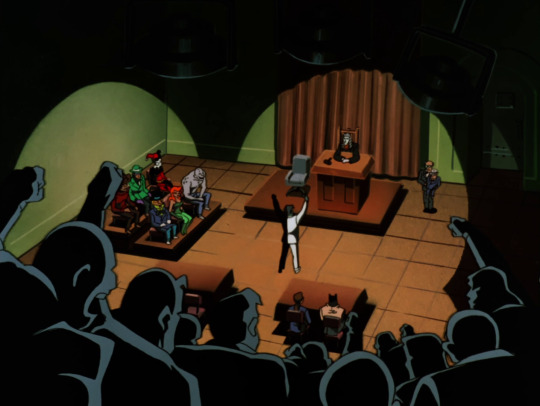
Tomorrow, I shall present the penultimate place in the countdown.
Hint: “Are you the dreamer, or merely part of someone’s dream?”
#list#countdown#best#favorites#new year's special#year of the bat#top 31 btas episodes#btas#batman: the animated series#dcau#dc#batman#animation#tv#number 3#trial#janet van dorn#bruce wayne#joker#harley quinn#poison ivy#mad hatter#scarecrow#killer croc#two-face#ventriloquist#scarface#arnold wesker#harvey dent#waylon jones
10 notes
·
View notes
Text
Year of the Bat - Number 4
Welcome to Year of the Bat! In honor of Kevin Conroy, Arleen Sorkin, and Richard Moll, I’ve been counting down my Top 31 Favorite Episodes of “Batman: The Animated Series” throughout this January. We’re getting close to the end now…
TODAY’S EPISODE QUOTE: “Gotham can be a Wonderland, Alice! Tonight, let me be your guide.”
Number 4 is…Mad as a Hatter.
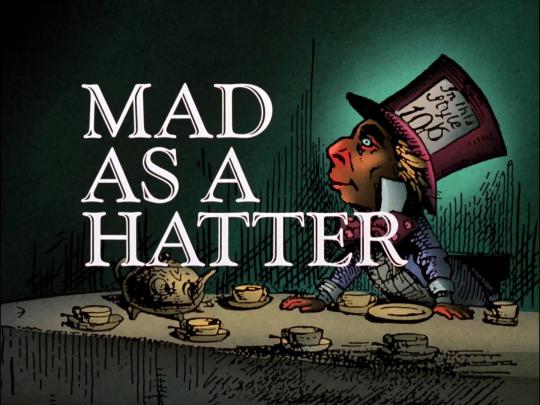
If you know me very well, this episode being in my Top 5 is no surprise at all. If you don’t, then you might be a little surprised. While “Mad as a Hatter” is certainly a well-liked episode, by all accounts, I doubt too many people would name it as being anywhere on-par with stories like “Mad Love” and “Heart of Ice,” two other villain origin stories that I covered in my past two entries. I, however, am not most people: while I love Harley Quinn, and I cannot deny the power of “Heart of Ice,” this story is something close to my heart in a way those two simply are not.
This episode is the origin/first appearance of one of the Dark Knight’s slightly more unsung villains, the Mad Hatter. In the story, the Hatter is a highly repressed and socially awkward neuroscientist, by the name of Jervis Tetch. Jervis is an eccentric fellow, who has a bizarre obsession with the “Alice” stories by Lewis Carroll. The strange scientist has created a special headband and cards, which – via highly sophisticated nanotechnology – allow him to control other people’s minds. It’s then revealed that Tetch has unrequited feelings for his secretary (probably not-coincidentally named Alice Pleasance), and – when her boyfriend, Billy, seemingly dumps her – Jervis seizes the opportunity to use this newfound power to try and sweep Alice off her feet.
At first, things seem to go well…but unbeknownst to Jervis, after he drops Alice off at home that night, she and Billy make up and even get officially engaged. This sudden development causes Jervis to snap, and he becomes the Mad Hatter: determined to claim Alice as his own, hang all the consequences, and willing to put half of Gotham under his thrall, if necessary, in order to do so. Naturally, Batman can’t allow this; he’s already on Tetch’s trail, after a (presumed) misunderstanding with some street thugs. Now, he must rescue Alice (and Billy) and stop the Mad Hatter before things get any madder.
The Mad Hatter has long been one of my favorite Batman Villains, and I am 99% convinced that the specific version found in the DCAU is the main reason why. In the comics, the Hatter has always been an…iffy character, to say the least, as he’s typically depicted as a rotten-to-the-core little creep with many perverse desires. He’s a villain who’s meant to just be punched in the face, so to speak. Other adaptations have gone in other directions, but I think the version found in the Animated Series handled it the best out of anybody. This is, without a doubt, my definitive take on the Mad Hatter.
Part of the reason why is the character’s voice: he’s played by Roddy McDowall, and in fact, the Hatter would be McDowall’s last proper character, as his final appearance in the DCAU – a Superman crossover episode called “Knight Time” – was released posthumously to McDowall’s passing, and a somewhat earlier episode, “Animal Act,” was released not long before his death. This was quite the role to cap a career with, and almost seems an inevitable one: McDowall had previously played a somewhat similar character, the Bookworm, in the 1960s Adam West show. He also was the narrator for an abridged audiobook version of Tim Burton’s Batman (where I swear he plays the most polite Batman in the history of anything). Not only that, but McDowall also played the role of the March Hare in a 1985 TV Miniseries of “Alice in Wonderland.” With credits like these, and his mellifluous voice, he was absolutely perfect casting for the part.
The other reason, however, sits with his origins. This by far the most sympathetic and fascinating take on Jervis Tetch I think we’ve ever been given. It’s easy to relate with the idea of unrequited love as the cause for someone’s descent into darkness, and at the start of the story, Jervis is really very nice. He’s a bit odd, and there are some subtle hints that he’s already on a slightly uneven keel, but he doesn’t come across as truly evil. There’s also an interesting dichotomy with the way his alter ego acts in relation to the rest of his life; it sort of reminds me of Catwoman’s setup in “Batman Returns,” of all things. At the start, Jervis is awkward, shy, panicky, and keeps a lot bottled up. Once he dons the top hat and trenchcoat of the Mad Hatter, however, he becomes a whole different person: he’s more charismatic, more confident, more flamboyant, and – thanks the power of his control chips – he has absolute control, something we get the sense he hasn’t had a lot of in his life. It’s only when his advances are so brutally shot down – when he finds out Alice, after all that, is ENGAGED to Billy – that he REALLY goes off the deep end. There’s some ambiguity and unanswered questions with his background – we don’t know why he’s obsessed with Wonderland, why he’s created these control chips, or even whether or not he intended what happened with the two aforementioned street hooligans – but that actually only makes him more interesting, as it gives the audience a little leeway to come up with their own thoughts, while still presenting a comprehensive understanding of why this Hatter is Mad.
Being a Wonderland-obsessed oddball myself, I’ve always felt a sort of dark kinship, for lack of a better way of putting it, with the concept of Jervis Tetch. That character concept has never been so splendidly handled as in B:TAS, and “Mad as a Hatter” is a phenomenal first impression for the character. I need no other reason to place it so high in my personal ranks.
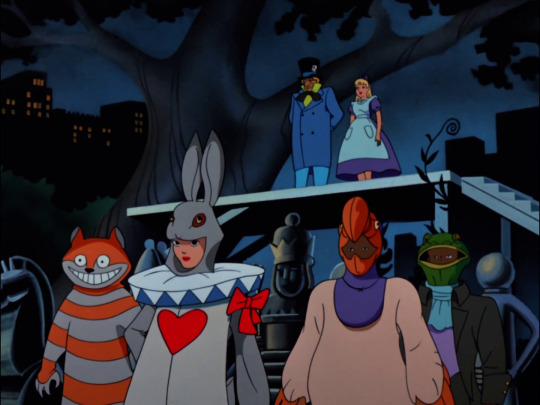
Tomorrow we move into the Top 3 of the countdown!
Hint: “Look at us. We’re all freaks and monsters. And who made us this way? BATMAN!”
#list#countdown#best#favorites#new year's special#year of the bat#top 31 btas episodes#btas#batman: the animated series#dcau#dc#batman#animation#tv#number 4#mad as a hatter#mad hatter#jervis tetch#roddy mcdowall#alice pleasance
18 notes
·
View notes
Text
Year of the Bat - Number 7
Welcome to Year of the Bat! In honor of Kevin Conroy, Arleen Sorkin, and Richard Moll, I’ve been counting down my Top 31 Favorite Episodes of “Batman: The Animated Series” throughout this January.
TODAY’S EPISODE QUOTE: “How could you? I worked with you, trusted you, and you never told me?!”
Number 7 is…Over the Edge.

Many consider this episode to be one of the best of the TNBA era of the Animated Series. I am, very obviously, highly inclined to agree. “Over the Edge” might well be the single darkest episode of the entire show, and that’s saying a lot. (The only possible competition it may have in my mind is “Growing Pains,” another TNBA outing I covered much earlier in the countdown.) It’s not dark because it involves scary imagery, or gruesome and physically twisted concepts, but because it puts the characters at the absolute peak of tension, with things getting more and more bleak as the story goes on, and it never really lets up.
The episode literally opens with a shootout inside the Batcave. No joke. Commissoner Gordon and the rest of the GCPD are racing through the Batcave’s tunnels, gunning for the Dark Knight and his allies, and it’s made clear that Gordon knows who Bruce Wayne is. Alfred gets arrested, giving Batman, Robin, and Nightwing a chance to escape. While in hiding, Batman recounts how things have gone down for the audience’s benefit: it’s revealed that, during a battle with the Scarecrow, Batgirl was knocked off a building, and landed right on top of Commissioner Gordon’s car. She dies as a result of the fall shortly thereafter, at which point Gordon learns the truth of how the heroine was Barbara, his daughter.
Now in the present…blaming Batman for Barbara’s demise, Gordon and Harvey Bullock effectively wage war against the Bat-Family. The Commissioner is more outraged than ever when he learns Bruce Wayne is the Caped Crusader. Even the public seems incensed, and some of the villains get a quick cameo as they try to gain support and form a lawsuit against the Dark Knight. Nightwing is eventually captured, and Tim Drake is forced to give up the mantle of Robin and go into hiding. Finally, Gordon makes the most drastic of moves, as he teams-up with Bane, of all villains, to destroy Batman once and for all.
So…first of all, JESUS H. CHRIST, THAT’S A LOT TO TAKE IN. Every few SECONDS, it seems, throughout this episode, another point of suspense and dread rises up. The story just does not let up, as the situation spirals further and further out of control. With Gordon on the brink of madness and Batman on the brink of self-destruction at every turn, this is easily one of the most harrowing tales of the entire series. Neither is vilified here, and the voice artists for these two characters are what really sell the emotional impact: this is by far Bob Hastings’ most startling turn as Gordon, as you see him pushed to his breaking point and transformed into an antagonist. Conroy is equally powerful as Batman, as you can sense the pain in his own vocals and the way the fear and sorrow build for him as the story goes on. Bane’s presence as the main villain (though not the main antagonist) is also a welcome addition. We didn’t get much of him in the show, but this is by far his most memorable outing.
I do feel I HAVE to spoil the ending to this episode, though, so…for those who have not seen it, SPOILER ALERT: as you might have guessed, Batgirl isn’t really dead. In fact, it’s revealed that none of the events actually happened. Batgirl and the others DID face the Scarecrow…but the villain didn’t knock her off a building. Instead, he gassed her with a special form of his Fear Toxin, which put Batgirl into a deep sleep, where her absolute worst nightmare was illustrated in vivid, lurid detail. Thankfully, Bruce and the team are able to bring her back to health.
The episode doesn’t just stop there, though. Even more than all the horrors the story puts before our eyes, I think my favorite part is the very ending. Disturbed by her dreams while under Scarecrow’s influence, Batgirl goes to talk to her father, planning to confess her identity to him. Gordon, however, stops her, and tells Barbara that she doesn’t need his approval: he trusts her to make her own decisions, he won’t blame anyone else for them, and he will always love her. Not only is the ending heartwarming, but I love how the dialogue subtly hints that Gordon may know the truth of Barbara’s secret identity already, while still leaving that teasingly ambiguous. Either way, I love how – after all the suspense and dread the story slams into us over and over again – it ends with such a wholesome, warm, yet poignant conclusion. It’s also yet another reason I credit this as Hastings’ best performance for the Commissioner: the fatherly warmth of this scene is just as impactful as the bitter vengeance and spite from before.
While the twist of “it was all a dream” can seem a bit…iffy for some people, I think we all knew this couldn’t actually be real, or that there had to be some catch to it, so to speak, so I don’t really mind much. It doesn’t take away from what makes the story great: for both its darkness, and its hidden speck of interesting light, it is an absolute marvel, and one the Animated Series’ most rightfully lauded gems. Honestly, I’m kind of disappointed in myself for not placing it higher…but hopefully the stories still to come will not disappoint.

Tomorrow we move on with Number 6!
Hint: “It would move me to tears, if I had tears to shed.”
#list#countdown#best#favorites#new year's special#year of the bat#top 31 btas episodes#btas#batman: the animated series#tnba#the new batman adventures#dcau#dc#batman#animation#tv#number 7#over the edge#bruce wayne#bane#commissioner gordon#bob hastings#kevin conroy#tara strong#batgirl#barbara gordon#scarecrow#jonathan crane
11 notes
·
View notes
Text
Year of the Bat - Number 11
Welcome to Year of the Bat! In honor of Kevin Conroy, Arleen Sorkin, and Richard Moll, I’m counting down my Top 31 Favorite Episodes of “Batman: The Animated Series” throughout this January.
TODAY’S EPISODE QUOTE: “Why don’t you show them what an overdose can do, Daggett? Why don’t you tell them about ME?!”
Number 11 is…Feat of Clay.

In the comics, there have been multiple takes on the shapeshifting fiend known as Clayface. In B:TAS, the showrunners created their own take on the character, by blending elements of basically all the different versions of the character that had existed together into one entity. For many, the version of the character that appears in the DCAU is, was, and always will be the most iconic and definitive portrayal of the character. I am inclined heavily to agree, and much of what made Clayface so great started with his very first appearance: the two-part origin story, “Feat of Clay.”
The focal character is an actor named Matt Hagen; a once charismatic performer who was famed not only for his supreme talents, but also his good looks. However, after a tragic accident, Hagen was hideously mutilated. He thought his career was over, until Roland Daggett – who previously was mentioned on this countdown as one of the main antagonists of the episode “Appointment in Crime Alley” – came to him with an offer. Daggett’s company had created a special “beauty cream,” called Renuyu: a chemical compound that would allow Hagen to mold the features of his face into any shape he wished. Unfortunately, this turned out to be a deal with the devil: not only was the compound highly addictive, and might have even messed with Matt’s mind, but the need to use Renuyu led the actor to becoming Daggett’s unwitting stooge on many schemes.
When one of these schemes – an attempt to frame Bruce Wayne himself for a crime – goes awry, and Batman naturally gets involved, Daggett decides that Hagen is too much of a liability, and has outlived his usefulness. His goons capture Matt and pour gallons of raw, unrefined Renuyu down his gullet, in the hopes of killing Hagen. Instead, this causes Hagen to transform into the hideous beast Clayface, and the former entertainer goes on a quest of revenge to destroy Daggett for all the misery he’s caused him.
This is one of the standout episodes of the show for a lot of reasons. It’s one of the single best animated, from start to finish, with some extremely striking and shockingly well-detailed visuals, courtesy of Clayface’s many transformations. In fact, apparently, part of the reason Clayface didn’t appear that often in the series was because it was so expensive to animate the character’s shapeshifting and body-morphing abilities. (I’m not complaining, though, because they made sure every single one of those appearances were awesome.) The episode is also one of the more brutal in the series, as Batman goes to some particularly extreme measures to take down Daggett’s cronies, and the body horror aspects with Clayface and his origins are downright sickening, even to this day; it’s kind of surprising the show was able to get away with it. Combine that with a delightfully unnerving twist ending (which I won’t reveal here), and you have one of the finest villain origins of the whole show, and arguably Clayface’s greatest moment.

Tomorrow we enter the Top 10!
Hint: “Change is everything.”
#list#countdown#best#favorites#new year's special#year of the bat#top 31 btas episodes#btas#batman: the animated series#dcau#dc#batman#animation#tv#number 11#feat of clay#clayface#matt hagen#roland daggett
8 notes
·
View notes
Text
Year of the Bat - Number 15
Welcome to Year of the Bat! In honor of Kevin Conroy, Arleen Sorkin, and Richard Moll, I’m counting down my Top 31 Favorite Episodes of “Batman: The Animated Series” throughout this January. We’ve officially entered the Top 15!
TODAY’S EPISODE QUOTE: “Kids these days. No respect.”
Number 15 is…Legends of the Dark Knight.
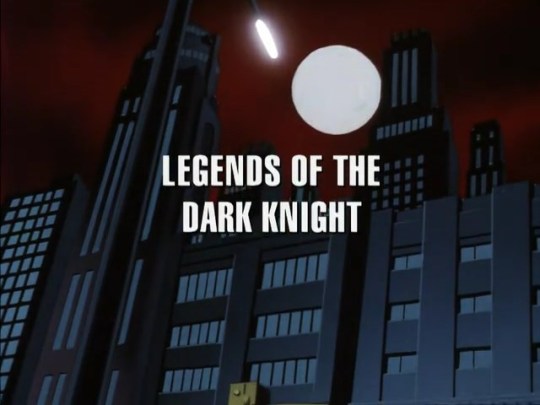
One of the great things about many famous comic book characters is their adaptability. Some of these characters were created nearly a century ago; Batman, for example, first appeared in the late 1930s. (He actually turns 85 Years Old this very year!) Some characters that old who were popular then have, for one reason or another, not stood the test of time. Batman has, and part of this is because his creators found him easy to adapt and reconfigure as times changed. Bruce Wayne and his universe have been portrayed more seriously or more goofily over the decades, and have been made to appeal to adults and children alike time and time again. “Batman: The Animated Series” is widely considered the most definitive take on the Caped Crusader and his world specifically because the writers who worked on this show understood this, and had a deep love for ALL sides of Batman’s world. The show, therefore, hits a near-perfect balance, overall, between silly superhero shenanigans, and dark, complex, sometimes downright brutal storytelling.
“Legends of the Dark Knight” is an episode that exemplifies not only the skillful balance of tone the Animated Series managed for the majority of its run, but acts as a tribute to the long and storied history of Batman, and the adaptability of the character. The plot focuses on a group of random children, living in Gotham, all of whom are gossiping about the mysterious Dark Knight. Through their banter, they start to share stories and theories about what Batman is really like, all of which pay homage to different past incarnations of Batman. Some of these references are relatively brief; for example, a passing friend of theirs named “Joel,” and his bizarre, strangely effeminate fixations on Batman, are meant to be a joking reference to Joel Schumacher’s much maligned film versions of the character. Another case is one young man who makes insinuations of Batman being some monstrous vampire, a reference to the Elseworlds “Batman & Dracula Trilogy” written by Doug Moench.
The most notable of these homages, however, are two long sequences of the show, acting essentially as stories within a story. The first is a tribute the late Golden Age and the Silver Age of comics, as well as to the Adam West 1960s TV series. It features an original adventure, with Batman and Robin battling the Joker, when the Clown Prince of Crime tries to steal the original score of the opera “Pagliacci.” The second sequence is taken directly from the pages of Frank Miller’s somewhat controversial (but highly influential) masterwork, “The Dark Knight Returns.” This one adapts and combines two scenes from the graphic novel, where Batman faces the despicable Mutant Leader. I love both these sequences; it’s neat to see the way the animation style changes for each to match the decade and story style (I especially love how the first sequence so accurately captures the look of Dick Sprang’s famous aesthetics). Interestingly, they also bring in new voice actors to play the characters in each one; instead of Mark Hamill, for example, Michael McKean plays the 60s-era Joker. Meanwhile, Michael Ironside – who would later play the devilish Darkseid for the DCAU – voices Frank Miller’s Batman. Both are perfect casting.
The episode ends with the kids bearing witness to the real Batman – Conroy’s vocals and all – duking it out with the villainous Firefly. I used to love this episode a lot more, but upon revisiting it, I felt I had lost some love for it, and I think part of it is this final sequence. While I love the idea of the kids encountering the real Batman after all that, and I suppose such a thing was inevitable with a plot like this…something about it feels underwhelming after the spectacular sequences we saw earlier in the episode. It’s hard for me to say what the issue is, but I don’t think that was the intention, based on the way things are set up and described in-story. Still, it’s not necessarily a bad ending, for various and probably obvious reasons. It’s a great episode that showcases a different perspective (several different perspectives, in fact) on Batman and the City as a whole, and if you’re as much of a fan of the history of this character – and the duality of the Animated Series itself – as I am, you owe it to yourself to give this one a quick peek. That is, of course, presuming you haven’t already.

Tomorrow we move on to Number 14!
Hint: “This used to be a beautiful street. Good people lived here once.”
#list#countdown#best#favorites#new year's special#year of the bat#top 31 btas episodes#btas#batman: the animated series#tnba#the new batman adventures#dcau#dc#batman#animation#tv#number 15#legends of the dark knight#joker#dark knight returns#firefly#garfield lynns#robin
7 notes
·
View notes
Text
Year of the Bat - Number 17
Welcome to Year of the Bat! In honor of Kevin Conroy, Arleen Sorkin, and Richard Moll, I’m counting down my Top 31 Favorite Episodes of “Batman: The Animated Series” throughout this January.
TODAY’S EPISODE QUOTE: “Man or woman, a sick mind is capable of anything.”
Number 17 is…Harley & Ivy.
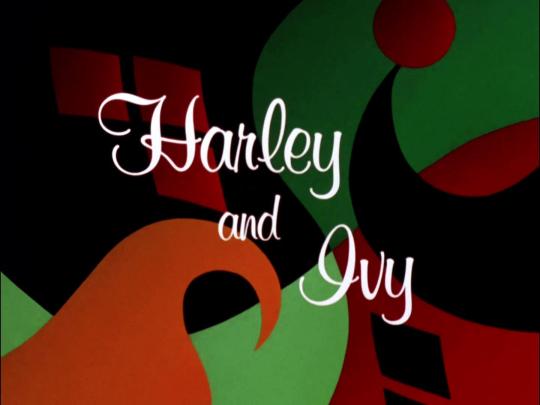
There are many episodes in B:TAS that can be considered “landmark moments,” not just for the show, but for the lore and history of Batman – in general – moving forward and into the present day. Characters and stories that were so well-conceived, and so incredibly interesting, that later writers, artists, and creators in general would find them to be fountains of inspiration, and which fans still adore to this day. “Harley & Ivy” is one of those landmarks. It not only expanded on the character of Harley Quinn – thus further ensuring her long-lasting legacy as a character – but also on the much older character of Poison Ivy, and provided perhaps one of the most popular supervillain duos in the history of fiction.
Once again, Batman is sort of a secondary player in things for this outing. The focus of the story, really, is on three of his greatest villains: Harley, Ivy, and his arch-nemesis, the Joker. The plot begins when Joker, angry at Harley after a botched robbery, kicks her out of the gang. It’s indicated this isn’t the first time this has happened, and Harley – fed up with the Clown Prince’s ego (despite still having feelings for him) – decides to try and show him up by pulling off a few crimes on her own. Her schemes cause her to come in contact with Poison Ivy, and the two decide to team-up, as Ivy seeks to drill some more backbone and independence into her new partner-in-crime. When their crimes lead to them upstaging the Harlequin of Hate, however, Joker is quick to try and get some revenge. Out to stop all three villains, Batman is dragged into the mess, as usual.
This episode really solidified the relationship between Harley and the Joker. In earlier stories, they’d actually gotten along rather well, but this is the first story where we see the unhealthy, dangerous side of their relationship. Over time, writers and creators have gone back and forth on how toxic or how surprisingly touching the relationship should be, but this was the status quo with the original Animated Series version of Harley moving forward: the Joker is awful to Harley, an abusive creep of the highest order…yet he also can’t be without her a lot of the time, for one reason or another. Harley, meanwhile, is hopelessly devoted to the Ace of Knaves, but at times she’ll show a surprising amount of gumption, whenever the Joker does something she REALLY doesn’t agree with.
Of course, the real major relationship here is Harley and Ivy themselves, and in this first outing, it’s nailed perfectly. In the original show, the pair are essentially best friends, and were described as having a sisterly sort of bond. Later reinventions – as well as numerous fanworks – would go further, making the two into love interests; arguably the most popular lesbian couple in the history of superhero fiction. While you COULD argue there are hints of that in their interactions in this episode, and throughout the Animated Series as a whole, I don’t necessarily feel like they were intentional…but regardless of how you look at them – as lovers, sisters in bond, or simply very good friends – watching these two bounce off one another is just as great as seeing Harley and the Joker together. Sometimes even more so!
For Poison Ivy, I would argue, it’s ESPECIALLY interesting, because she’s so often depicted as a lone mama wolf, so to speak; a highly independent character who shows little to no empathy for most other human beings. Yet for some reason, you can tell Ivy actually does legitimately care about Harley, even as early as this first appearance. Seeing Harley’s bubbly, childish, manic personality rebound off of Ivy’s more serious, sarcastic, sardonic attitude creates a lot of comedic and dramatic tension. It’s the Animated Series that really made me fall in love with Ivy as a character, and I think a big part of that DID come from her interactions with Harley. Out of all the other characters Harley has been paired up with besides the Joker in times since – from Deadshot, to Killer Croc, to Lobo, and so on – something about Harley & Ivy’s particular partnership remains arguably the strongest of all. It all started with this episode, and anyone who loves these characters owes it to themselves to check it out, if they haven’t already.
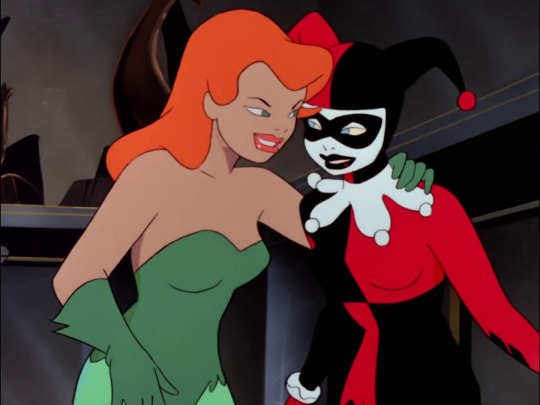
Tomorrow we move on to the halfway point of the countdown, with Number 16!
Hint: “Fear’s a prison, you see, and I’ve just broken out!”
#list#countdown#best#favorites#new year's special#year of the bat#top 31 btas episodes#btas#batman: the animated series#dcau#dc#batman#animation#tv#number 17#harley & ivy#harley quinn#harleen quinzel#poison ivy#pamela isley#joker
9 notes
·
View notes